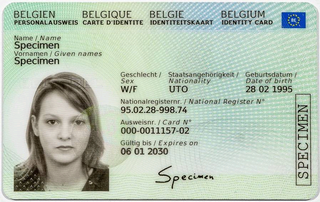An identity document is any document that may be used to prove a person's identity. If issued in a small, standard credit card size form, it is usually called an identity card, or passport card. Some countries issue formal identity documents, as national identification cards that may be compulsory or non-compulsory, while others may require identity verification using regional identification or informal documents. When the identity document incorporates a person's photograph, it may be called photo ID.

An electronic identification ("eID") is a digital solution for proof of identity of citizens or organizations. They can be used to view to access benefits or services provided by government authorities, banks or other companies, for mobile payments, etc. Apart from online authentication and login, many electronic identity services also give users the option to sign electronic documents with a digital signature.

The province of Rimini is the southernmost province of the Emilia-Romagna region of Italy. Its capital is the city of Rimini, one of the "seven sisters" of the historical region of Romagna.
A national identification number, national identity number, or national insurance number or JMBG/EMBG is used by the governments of many countries as a means of tracking their citizens, permanent residents, and temporary residents for the purposes of work, taxation, government benefits, health care, and other governmentally-related functions.

A Belgian identity card is a national identity card issued to all citizens of Belgium aged 12 years old and above.

The cédula de identidade is the official national identity document in Brazil. It is often informally called carteira de identidade, "RG" or simply identidade in Portuguese. The card contains the name of the bearer, filiation, place of birth, date of birth, signature and thumbprint of the bearer. Other national documents can legally be used as an identity card, such as a federative unit-issued driver's license, passport or, for minors, a birth certificate. Each card has a unique RG number. As of 11 January 2023, the CPF number will be used as the RG number on new identity cards.

Lesbian, gay, bisexual, and transgender (LGBT) people in San Marino may face legal challenges not experienced by non-LGBT residents. Both male and female same-sex sexual activity are legal in San Marino, but households headed by same-sex couples are not eligible for the same legal protections available to opposite-sex couples.

The Romanian identity card is an official identity document issued to every Romanian citizen residing in Romania. It is compulsory to obtain the identity card from 14 years of age. Although Romanian citizens residing abroad are exempt from obtaining the identity card, if they intend to establish a temporary residence in Romania, they may then apply for a provisional identity document, which is valid for one year (renewable).

The Italian electronic identity card, or simply carta d'identità, is an identification document issued to any Italian citizen and to legal aliens, that has been progressively replacing the paper-based identity card since version 3.0 was first released on 4 July 2016. The CIE is intended for both digital and physical identification. The biometric information is printed on an ID-1 card and stored in a contactless chip.
San Marino has recognized civil unions for both same-sex and opposite-sex couples since 5 December 2018. The law to permit civil unions became fully operational on 11 February 2019, following a number of further legal and administrative changes.

The Documento Nacional de Identidad (DNI) or carnet de identidad is a national identity document compulsory to all citizens of Spain aged fourteen and above. It has a personal, unique and exclusive identification number or número de DNI –made up of eight digits plus a control letter– that is assigned to the holder the first time he/she obtains the document and that keeps throughout his/her life as a general identifier.

The Moldovan identity card, from 2025 – is a compulsory identity document issued in the Republic of Moldova. Every Moldovan citizen who resides in the Republic of Moldova must have an ID card. Moldovan ID cards are issued by the Public Services Agency. The following are required to have an ID card: from birth until 10 years of age, from 10 years of age until 16, from 16 years of age until 25, and from 25 years of age until 45. After 45 years of age, the ID card is not required to be renewed.

Documento Nacional de Identidad or DNI, is the main identity document for Argentine citizens, as well as temporary or permanent resident aliens. It is issued at a person's birth, and must be updated at 8 and 14 years of age, and thereafter every 15 years. It takes the form of a card, and is required for voting, payments, military service inscriptions and formalities. They are issued by the National Registry of Persons (RENAPER).

The Slovenian identity card is issued to Slovenian citizens. It can be used as a travel document when visiting countries in Europe, as well as Georgia, French overseas territories, Montserrat and organized tours to Tunisia.

The national identity cards are identity documents issued to citizens of nations in the European Union (EU) and European Free Trade Association (EFTA) member states, with the exception of Denmark and Ireland. The identity cards have been harmonized as a new common identity card model replaced the various formats in use on 2 August 2021.

The law of Italy is the system of law across the Italian Republic. The Italian legal system has a plurality of sources of production. These are arranged in a hierarchical scale, under which the rule of a lower source cannot conflict with the rule of an upper source.
The Polizia Postale e delle Comunicazioni is one of the units of the Polizia di Stato, the State Police of Italy. Its functions include the investigation of cybercrime.

The Gelmini reform refers to the set of acts of the Italian Republic – issued during the Berlusconi IV Cabinet – concerning the education sector in Italy.
The Military ranks of San Marino are the military insignia used by the Sammarinese Armed Forces. Due to the history of San Marino and its cultural ties to Italy, San Marino has a similar rank structure to that of Italian Armed Forces.
The 2020 San Marino local elections were held on 29 November, to elect the mayors and the councils of the 9 municipalities of San Marino. These elections were initially scheduled to take place on 15 December 2019, but were postponed to 21 June 2020 due to a snap general election called for 8 December. Due to the COVID-19 pandemic, elections were postponed once again to 29 November 2020.














